A national project, involving some of Australia's leading farming stakeholders, is focused on improving the adoption of precision agriculture (PA) technologies in vegetable production systems.
Queensland's Department for Agriculture and Fisheries (DAF) has been leading a Hort Innovation funded project that has been working with growers to implement these technologies on-farm and developing case studies on how these technologies can be used in Australian vegetable production systems.
"These technologies primarily provide spatial information on vegetable crops or fields," DAF's Senior Development Horticulturist, Julie O’Halloran said. "Commercially available image analysis can then be applied to the spatial data for various purposes. The information from these technologies can be used in various ways to inform farm operations and management practices. For example, to quantify lost production from underperforming areas, target crop inputs, forecast yield for product marketing and packing shed logistics. GPS technologies enable specific points in a field to be accurately identified, and for crop performance and management options, such as variable-rate input applications, to be based on what is happening/required at that specific point in the field."
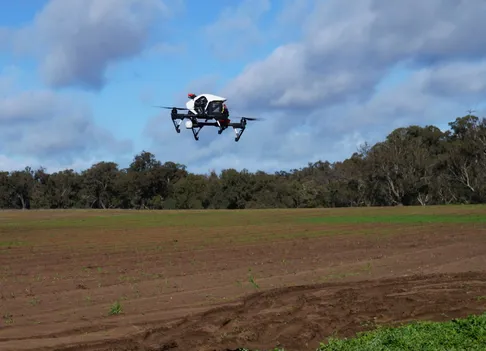
Photo:Drone in vegetable crops (Source: Rachel Lancaster, EATS)
The project will conclude in March 2020, with drones are one of the technologies being looked at as part of this project. Ms O’Halloran says DAF has coordinated training for commercial agronomists who are interested in offering drone applications as part of their services.
"These agronomists have purchased drones and are able to fly them but getting useful and valuable data is the more complex step," she said. "The training has focused on how to capture, process and analyse crop imagery to extract useable data that would have value for a vegetable business."
DAF has also been working with co-operating growers on various applications of drones, including crop sensing imagery to identify variability in crop growth, and particularly where areas of the crop are underperforming, such as low biomass and yield or delayed maturity. In addition, commercially available image analytics have been used for automated plant counts to forecast yield, estimates of flowering areas to assess maturity and provide additional information to assist with field operations, and 3D modelling of crops.
"Drones are essentially a platform for different sensors or payloads," Ms O’Halloran said. "This technology is extremely novel for vegetable systems and still limited in its application. Limited use of drones on vegetable farms has previously been focused on capturing aerial imagery or video of crops and farms without much if any imagery analytics. There is potential to use drones on vegetable farms to identify differences in crop growth, forecast yields, identify weeds for targeted control (spot spraying), the release of beneficial insects into crops to assist with pest control through natural predation. Drones can provide high-resolution crop imagery, down to resolutions of mere centimetres per pixel."
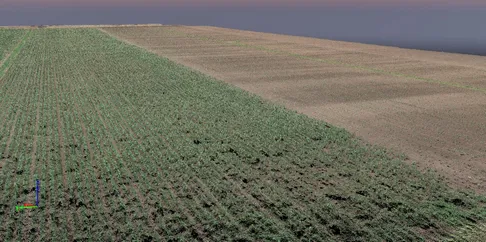
Photo: Imagery of sweet corn from a drone, which is then modelled into a 3D model of the crop. (Source: Nat Parker, Airborn Insight)
Drones are just one of many precision agriculture technologies, but Ms O’Halloran says there is a range of technologies for soil mapping, obtaining crop imagery, variable rate technologies to variably apply crop inputs, precision drainage management technologies.
"The primary output of precision agriculture technologies and approaches is more detailed spatial information that can be used in various ways to inform farm operations and management practices," she said. "Precision agriculture approaches can provide multiple benefits such as understanding crop constraints, improved crop uniformity (yield) and optimised (or targeted) inputs, thus improving efficiencies across the production system."
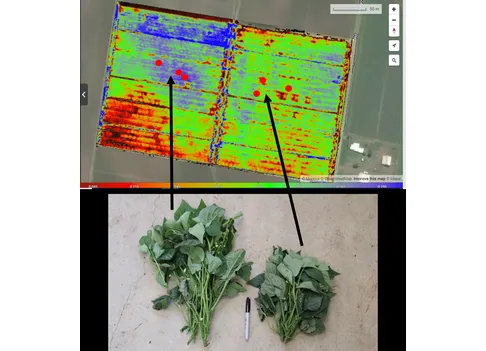
Photo: Crop sensing imagery showing differences in green bean biomass as indicated by plants from a high crop vigour areas (blue) compared with a plant from low crop vigour areas (red/green). (Source: DAF)
However, Ms O’Halloran adds that PA technologies are still limited in their uptake within vegetable production systems, but through this project there is more evidence on how they can be used, the outcomes of using them and what the potential is for return on investment for vegetable systems.
"The uptake of precision agriculture technologies is influenced by many factors," she said. "A key factor is awareness of available technologies and this project has been focused on increasing awareness and understanding of commercially available ag tech. In particular uptake of these technologies does require support by precision agriculture specialists and service providers and there are many vegetable growing regions in Australia that have limited access to these services so the project has also been working towards facilitating linkages between vegetable growers and service providers."
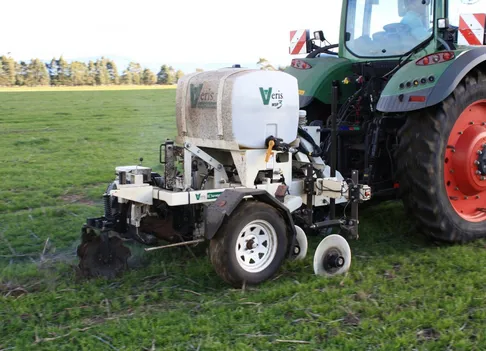
Photo: Veris soil mapping equipment for mapping soil pH. (Source: John McPhee and Will Whishaw)
Another important factor to take into account when implementing these technologies, according to Ms O’Halloran is that it is important to understand what the purpose is.
"For example, the purpose of using a drone will determine what sensor is to be used, and the flight specifications to obtain useful data. These technologies will not replace walking the crop as a grower or agronomist would, rather they are a tool used to provide information on where to go in a crop and where to target management to specific areas of a crop. These technologies provide information on variability, but targeted field sampling is still required to quantify the variability, or work out what is causing it."
DAF has been working alongside numerous project partners, including; the University of New England (UNE), Tasmanian Institute of Agriculture (TIA), Primary Industries and Regions SA (PIRSA), Society for Precision Agriculture Australia (SPAA), Vegetables WA, Harvest Moon (Tas).
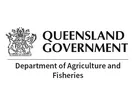 For more information
For more information
Queensland Department of Agriculture and Fisheries
Phone: +61 7 5381 1300
info@daf.qld.gov.au
